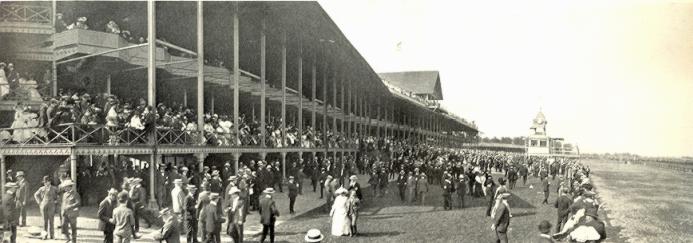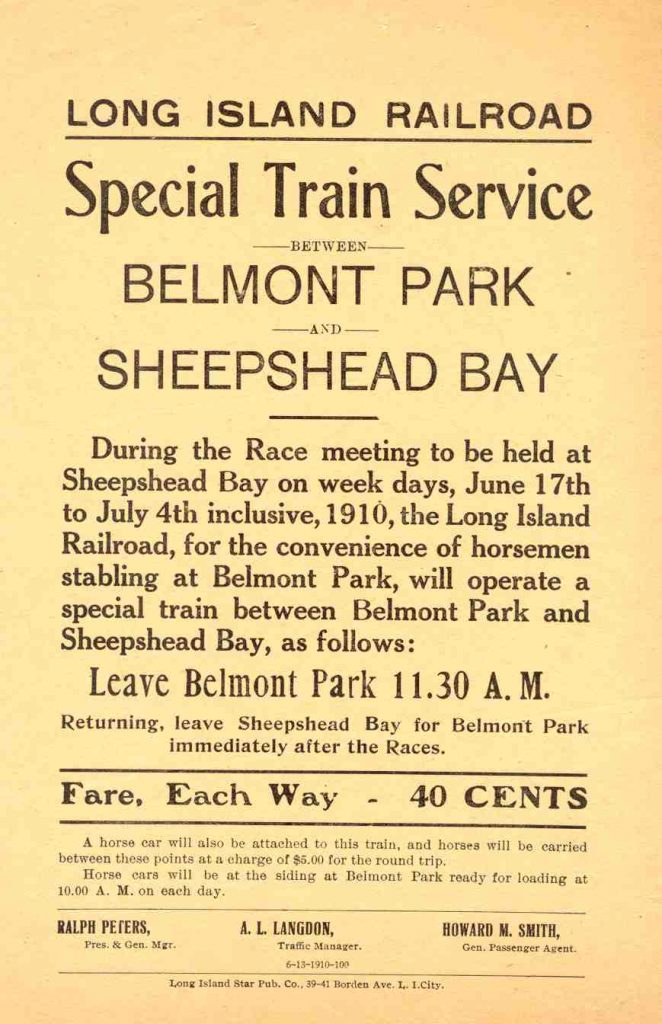
Sheepshead Bay Brooklyn, the home of the original Triple Crown in horseracing and our own Jonathan Stettin and Geo Sette
The Triple Crown that consists of the Kentucky Derby, Preakness and Belmont Stakes may be American racing’s most coveted prize but it’s not the first three-race series to brandish that title. Twelve years before Sir Barton unknowingly swept what would later become the modern Triple Crown, Sheepshead Bay Racetrack had devised their own short-lived series of races under the same name. Billed as the $77,000 Sheepshead Bay Triple Crown, it was comprised of the 1 ¼ mile Tidal Stakes, the 1 ½ mile Coney Island Jockey Club Stakes and the 1 5/8 mile Lawrence Realization and run over a period of 2 ½ weeks. The modern Triple Crown’s five week time frame almost seems luxurious by comparison. The purses for the original Triple Crown were impressive for the era – $20,000 for the Tidal Stakes, $25,000 for the Coney Island Jockey Club and $22,000 for the Lawrence Realization with all three races being run at the same track – Sheepshead Bay. A $10,000 bonus was also offered to any horse that swept the series. In this respect the Sheepshead Bay Triple Crown was more progressive than its successor which did not offer a bonus until the Spend a Buck debacle in 1985. While the original Triple Crown series was named before the actual races were run, the modern version wasn’t christened the Triple Crown until after Gallant Fox had accomplished the deed in 1930.
In 1907 the first $77,000 Sheepshead Bay Triple Crown series was run and all three races were won by different horses – Peter Pan, the Tidal Stakes, Frank Gill, the Coney Island Jockey Club, and Dinna Ken, the Lawrence Realization. In 1908, the undefeated Colin looked to be a cinch to win the Triple Crown. As a two year old, he’d won twelve straight races and been voted Champion Two-Year-Old Male and Horse of the Year. At three, he won the Withers and Belmont Stakes before cruising to victory in the Tidal. And then disaster struck – Colin spiked a fever before the Coney Island Jockey Club Stakes and was scratched. Having lost all four of his matchups with Colin, Fair Play now had an opportunity to shine and did he ever – sweeping the final two legs of the Triple Crown. Fair Play would go on to sire Man O’War who would also win 2/3rds of a Triple Crown. In Man O’War’s case it was the modern Triple Crown, a series he surely would have won had he been allowed to run in the Kentucky Derby.
The budding Triple Crown series that attracted champion horses and offered big purses was dealt a devastating blow on June 11, 1908 when the Hart-Agnew Law was passed. With wagering now rendered illegal, Sheepshead Bay Racetrack had no choice but to lower their purses for the 1909 Triple Crown. While Hilarious captured the Tidal that year, the prestige of the Coney Island Jockey Club and Lawrence Realization was enough to lure the great Fitz Herbert to compete in the final two races. Unfortunately, he literally scared off his competition, winning the Coney Island Jockey Club in a walkover. Fitz Herbert followed it up by setting a world record in the Lawrence Realization. With a phenomenal seasonal record of 14 wins out of 15 starts, Fitz Herbert was voted Champion Three-Year-Old Male and Horse of the Year.
In 1910 an amendment to the Hart-Agnew Law was passed that closed the oral wagering loophole that had allowed racetracks to stay open. With the hatchet poised to fall, Sheepshead Bay conducted its final Triple Crown series. Once again, the purse monies were slashed and once again, one horse captured the final two legs of the Triple Crown. This time it was Sweep, the 1909 Champion Two-Year-Old colt. So impressive was he that only one other horse dared to face him in the Belmont Stakes – and got trounced by six lengths for his effort. After skipping the Tidal Stakes which was won by The Turk, Sweep made short work of the final two Triple Crown races. Awarded Champion Three-Year-Old Colt in 1910, Sweep would later have a major impact on the modern Triple Crown as a broodmare sire. His daughter Brushup was the dam of 1937 Triple Crown winner War Admiral while Dust Whirl produced the 1941 winner, Whirlaway.
In 1911, Sheepshead Bay Racetrack closed its doors forever and America’s first Triple Crown series was no more. Although the Sheepshead Bay Triple Crown lasted only four years and failed to produce a winner of the series, it showcased America’s best three year olds competing in three prestigious races, planting the seed for what we all know now as simply The Triple Crown.
Photos Arts Archives




